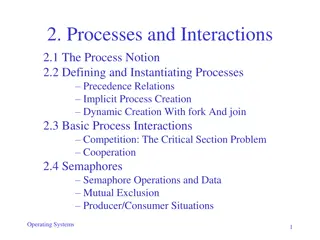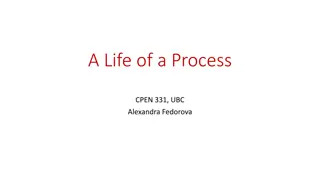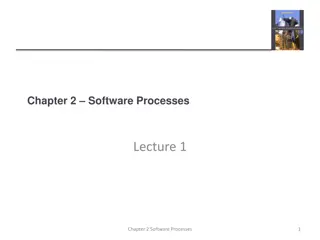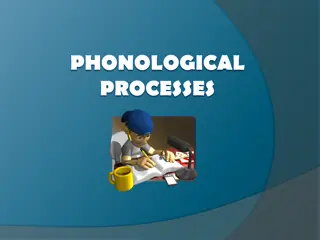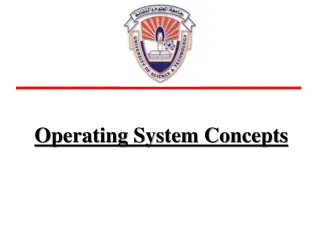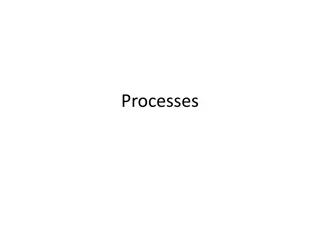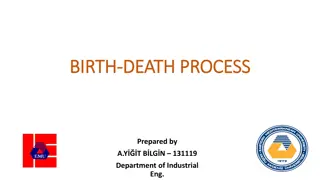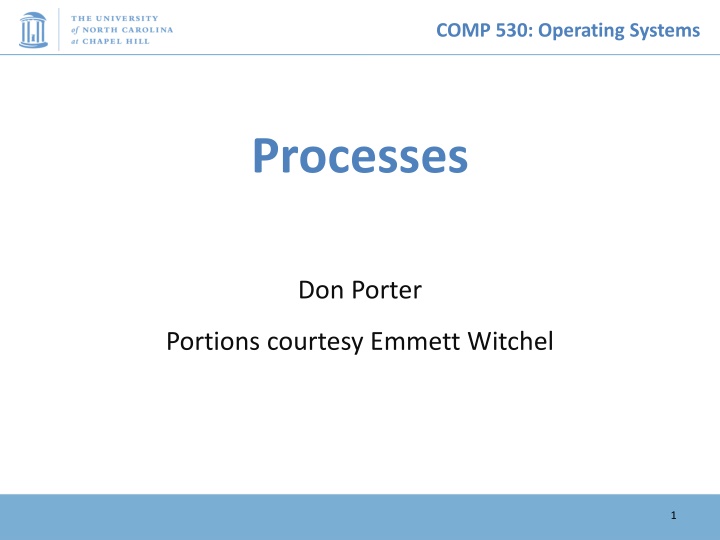
Operating Systems Processes in COMP 530
Explore the concept of processes in operating systems, from what a process is to how programs are transformed into processes in memory and where processes originate from. Dive into the details of how loaders set up programs, the role of the CPU, and the resources needed for process execution.
Download Presentation

Please find below an Image/Link to download the presentation.
The content on the website is provided AS IS for your information and personal use only. It may not be sold, licensed, or shared on other websites without obtaining consent from the author. If you encounter any issues during the download, it is possible that the publisher has removed the file from their server.
You are allowed to download the files provided on this website for personal or commercial use, subject to the condition that they are used lawfully. All files are the property of their respective owners.
The content on the website is provided AS IS for your information and personal use only. It may not be sold, licensed, or shared on other websites without obtaining consent from the author.
E N D
Presentation Transcript
COMP 530: Operating Systems Processes Don Porter Portions courtesy Emmett Witchel 1
COMP 530: Operating Systems What is a process? Intuitively, one of these App App Daemon Libraries Libraries Libraries User Super- visor System Call Table (350 1200) Kernel Hardware 2-2
COMP 530: Operating Systems What is a process? A process is a program during execution. Program = static file (image) Process = executing program = program + execution state. A process is the basic unit of execution in an operating system Each process has a number, its process identifier (pid). Different processes may run different instances of the same program E.g., my javac and your javac process both run the Java compiler At a minimum, process execution requires following resources: Memory to contain the program code and data A set of CPU registers to support execution 3
COMP 530: Operating Systems Program to process We write a program in e.g., Java. A compiler turns that program into an instruction list. The CPU interprets the instruction list (which is more a graph of basic blocks). void X (int b) { if(b == 1) { int main() { int a = 2; X(a); }
COMP 530: Operating Systems Process in memory What you wrote: What is in memory: main; a = 2 X; b = 2 void X (int b) { if(b == 1) { int main() { int a = 2; X(a); } Stack Data Heap void X (int b) { if(b == 1) { int main() { int a = 2; X(a); } Code
COMP 530: Operating Systems Where to processes come from? When I type ./a.out , the binary runs, right? Really only true for static binaries (more on this later) In reality a loader sets up the program Usually a user-level program Can also be in-kernel, or split between both 6
COMP 530: Operating Systems Where to processes come from? In order to run a program, the loader: reads and interprets the executable file sets up the process s memory to contain the code & data from executable pushes argc , argv on the stack sets the CPU registers properly & calls _start() Program starts running at _start() _start(args) { initialize_java(); ret = main(args); exit(ret) } process is now running; no longer think of program When main() returns, OS calls exit() which destroys the process and returns all resources What bookkeeping does the OS need for processes? 7
COMP 530: Operating Systems Keeping track of a process A process has code. OS must track program counter (code location). A process has a stack. OS must track stack pointer. OS stores state of processes computation in a process control block (PCB). E.g., each process has an identifier (process identifier, or PID) Data (program instructions, stack & heap) resides in memory, metadata is in PCB (which is a kernel data structure in memory)
COMP 530: Operating Systems Context Switching The OS periodically switches execution from one process to another Called a context switch, because the OS saves one execution context and loads another
COMP 530: Operating Systems What causes context switches? Waiting for I/O (disk, network, etc.) Might as well use the CPU for something useful Called a blocked state Timer interrupt (preemptive multitasking) Even if a process is busy, we need to be fair to other programs Voluntary yielding (cooperative multitasking) A few others Synchronization, IPC, etc.
COMP 530: Operating Systems Process life cycle Processes are always either: Executing Waiting to execute, or Blocked waiting for an event to occur Done Start Ready Running Blocked 11
COMP 530: Operating Systems Process contexts I/O Process 1 OS Process 2 Device main{ User Process n ... read{ k: read() startIO() User Program 2 User Process 2 save state main{ schedule() User Process 1 } System Software endio{ schedule() interrupt Operating System save state k+1: } restore state Memory }
COMP 530: Operating Systems When a process is waiting for I/O, what is its state? 1. Ready 2. Running 3. Blocked 4. Zombie 5. Exited
COMP 530: Operating Systems CPU Scheduling Problem of choosing which process to run next And for how long until the next process runs Why bother? Improve performance: amortize context switching costs Improve user experience: e.g., low latency keystrokes Priorities: favor important work over background work Fairness We will cover techniques later 14
COMP 530: Operating Systems When does scheduling happen? When a process blocks When a device interrupts the CPU to indicate an event occurred (possibly un-blocking a process) When a process yields the CPU Preemptive scheduling: Setting a timer to interrupt the CPU after some time Places an upper bound on how long a CPU-bound process can run without giving another process a turn Non-preemptive scheduling: Processes must explicitly yield the CPU 15
COMP 530: Operating Systems Scheduling processes OS uses PCBs to represent a process Every resource is represented with a queue OS puts PCB on an appropriate queue. Ready to run queue. Blocked for IO queue (Queue per device). Zombie queue. When CPU becomes available, choose from ready to run queue When an event occurs, remove waiting process from blocked queue, move to ready queue.
COMP 530: Operating Systems Why use multiple processes in one app? Consider a Web server: get network message (URL) from client fetch URL data from disk compose response send response How well does this web server perform? With many incoming requests? That access data all over the disk? A single process cannot overlap CPU and I/O
COMP 530: Operating Systems Why use multiple processes in one app? Consider a Web server get network message (URL) from client create child process, send it URL Child fetch URL data from disk compose response send response Now the child can block on I/O, parent keeps working Different children can block on reading different files How does server know if child succeeded or failed?
COMP 530: Operating Systems Orderly termination: exit() After the program finishes execution, it calls exit() This system call: takes the result of the program as an argument closes all open files, connections, etc. deallocates memory deallocates most of the OS structures supporting the process checks if parent is alive: If so, it holds the result value until parent requests it; in this case, process does not really die, but it enters the zombie/defunct state If not, it deallocates all data structures, the process is dead Process termination is the ultimate garbage collection Web server ex: Child uses exit code for success/failure
COMP 530: Operating Systems The wait() system call Child returns a value to parent via exit() The parent receives this value with wait() Specifically, wait(): Blocks the parent until child finishes (need a wait queue) When a child calls exit(), the OS unblocks the parent and returns the value passed by exit() as a result of the wait() call (along with the pid of the child) If there are no children alive, wait() returns immediately
COMP 530: Operating Systems Zombies!!! A parent can wait indefinitely to call wait() The OS to store the exit code for a finished child until the parent calls wait() Hack: Keep PCB for dead processes around until: Parent calls wait(), or Parent exit()s (don t need to wait() on grandkids) And that is a zombie (done state) Will not be scheduled again 21
COMP 530: Operating Systems Where do processes come from? (redux) Parent/child model An existing program has to spawn a new one Most OSes have a special init program that launches system services, logon daemons, etc. When you log in (via a terminal or ssh), the login program spawns your shell
COMP 530: Operating Systems Approach 1: Windows CreateProcess In Windows, when you create a new process, you specify the program And can optionally allow the child to inherit some resources (e.g., an open file handle)
COMP 530: Operating Systems Approach 2: Unix fork/exec() In Unix, a parent makes a copy of itself using fork() Child inherits everything, runs same program Only difference is the return value from fork() Child gets 0; parent gets child pid A separate exec() system call loads a new program Like getting a brain transplant Some programs, like our web server example, fork() clones (without calling exec()). Common case is probably fork+exec
COMP 530: Operating Systems Program loading: exec() The exec() call allows a process to load a different program and start execution at main (actually _start). It allows a process to specify the number of arguments (argc) and the string argument array (argv). If the call is successful it is the same process but it runs a different program !! Code, stack & heap is overwritten Sometimes memory mapped files are preserved. Exec does not return!
COMP 530: Operating Systems fork() + exec() example In the parent process: main() int rv =fork(); if(0 == rv) { exec_status = exec( calc , argc, argv0, argv1, ); printf( Something is horribly wrong\n ); exit(exec_status); } else { printf( Shall I be mother? ); child_status = wait(rv); } // create a child // child continues here Exec should not return // parent continues here
COMP 530: Operating Systems A shell forks and execs a calculator int rv = fork(); if(rv == 0) { close( .history ); exec( /bin/calc ); } else { wait(rv); int rvc_main(){ irvq = 7; do_init(); ln = get_input(); exec_in(ln); int rv = fork(); if(rv == 0) { close( .history ); exec( /bin/calc ); } else { wait(rv); wait(rv); wait(rv); int rv = fork(); if(rv == 0) { close( .history ); exec( /bin/calc ); } else { } else { int rv = fork(); if(rv == 0) { close( .history ); exec( /bin/calc ); USER OS pid = 127 open files = .history last_cpu = 0 last_cpu = 0 pid = 128 open files = .history pid = 128 open files = last_cpu = 0 Process Control Blocks (PCBs)
COMP 530: Operating Systems A shell forks and then execs a calculator main; a = 2 main; a = 2 Stack Stack Stack Heap Heap Heap 0xFC0933CA int shell_main() { int a = 2; 0xFC0933CA 0x43178050 int shell_main() { int a = 2; int calc_main() { int q = 7; Code Code Code USER OS pid = 127 open files = .history last_cpu = 0 last_cpu = 0 pid = 128 open files = .history pid = 128 open files = last_cpu = 0 Process Control Blocks (PCBs)
COMP 530: Operating Systems Why separate fork & exec? Key issue: Inheritance of file descriptors, environment, etc. Or, making the shell work Remember how the shell can do redirection? ./warmup < testinput.txt File handle 0 (stdin) is opened to read testinput.txt The parent (shell) opens testinput.txt before fork() The child (warmup) inherits this open file handle Even after exec() 29
COMP 530: Operating Systems The convenience of separate fork/exec Decoupling fork and exec lets you do anything to the child s process environment without adding it to the CreateProcess API. int rv = fork(); If(0 == rv) { // Do anything (unmap memory, close net connections ) exec( program , argc, argv0, argv1, ); } fork() creates a child process that inherits: identical copy of all parent s variables & memory identical copy of all parent s CPU registers (except one) Parent and child execute at the same point after fork() returns: by convention, for the child, fork() returns 0 by convention, for the parent, fork() returns the pid of the child // child continues here // create a child
COMP 530: Operating Systems The CreateProcess alternative Windows does allow you to create a process that is initially suspended You can also change memory and handles of another process And then unblock it Somewhat isomorphic But a bit cumbersome And prone to security issues (loading threads and libraries in another app!) 31
COMP 530: Operating Systems At what cost, fork()? Simple implementation of fork(): allocate memory for the child process copy parent s memory and CPU registers to child s Expensive !! In 99% of the time, we call exec() after calling fork() the memory copying during fork() operation is useless the child process will likely close the open files & connections overhead is therefore high Any ideas to improve this?
COMP 530: Operating Systems Pro tool: vfork If you know you are going to call exec() almost immediately: Create a new PCB, stack, register state But not a new copy of the full memory You can change OS state and call exec safely You cannot: Return from the function that called fork() Touch the heap Probably other stuff Why does it improve performance? Avoids copies Unfortunate example of implementation influence on interface Current Linux & BSD 4.4 have it for backwards compatibility 33
COMP 530: Operating Systems Copy-on-write fork (preview) Idea: write protect everything in memory after a fork() Detect and copy only what you touch, until the exec() After exec(), remove write protection from child memory Common case: exec quickly Some overhead to setting copy-on-write, but cheaper than copying everything Uncommon case: fork never execs Eventually copy everything We will see more about this later 34
COMP 530: Operating Systems Process control OS must include calls to enable special control of a process: Priority manipulation: nice(), which specifies base process priority (initial priority) In UNIX, process priority decays as the process consumes CPU Debugging support: ptrace(), allows a process to be put under control of another process The other process can set breakpoints, examine registers, etc. Alarms and time: Sleep puts a process on a timer queue waiting for some number of seconds, supporting an alarm functionality
COMP 530: Operating Systems Tying it all together: The Unix shell while(! EOF) { read input Parse and identify the program to execute int rv = fork(); if(rv == 0) { exec( program , argc, argv0, argv1, ); } else { } // create a child // child continues here // parent continues here Translates <CTRL-C> to the kill() system call with SIGKILL Translates <CTRL-Z> to the kill() system call with SIGSTOP Allows input-output redirections, pipes, and a lot of other stuff that we will see later
COMP 530: Operating Systems Summary Understand what a process is The high-level idea of context switching and process states How a process is created Pros and cons of different creation APIs Intuition of copy-on-write fork and vfork

